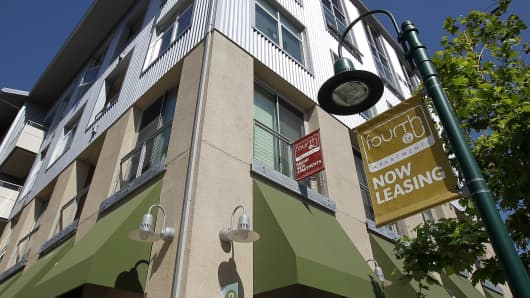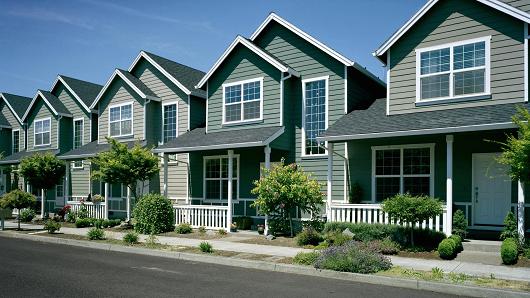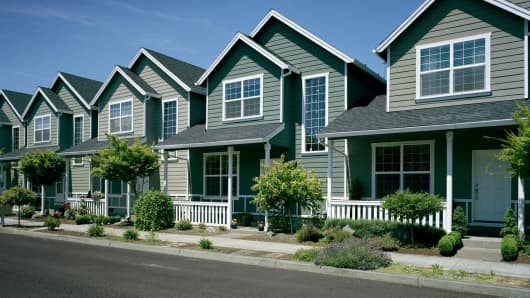The Great American Single-Family Home Problem
- The affordable-housing crunch is a nationwide problem, especially in California.
- California's median home price, at just over $500,000, is more than twice the national level and up about 60 percent from five years ago, according to Zillow.
- The Haskell Street project in Berkeley, California, exemplifies how developers are trying to gentrify U.S. neighborhoods.


BERKELEY, Calif. — The house at 1310 Haskell Street does not look worthy of a bitter neighborhood war. The roof is rotting, the paint is chipping, and while the lot is long and spacious, the backyard has little beyond overgrown weeds and a garage sprouting moss.
The owner was known for hoarding junk and feeding cats, and when she died three years ago the neighbors assumed that whoever bought the house would be doing a lot of work. But when the buyer turned out to be a developer, and when that developer floated a proposal to raze the building and replace it with a trio of small homes, the neighborhood erupted in protest.
Most of the complaints were what you might hear about any development. People thought the homes would be too tall and fretted that more residents would mean fewer parking spots.
Other objections were particular to Berkeley — like a zoning board member’s complaint that shadows from the homes might hurt the supply of locally grown food.
More from The New York Times:
How the Ferry Is Changing the Brooklyn-Queens Waterfront
When the Weekend House Becomes a Full-Time Home
New Zealand Examines Matt Lauder's House After Firing
Whatever the specifics, what is happening in Berkeley may be coming soon to a neighborhood near you. Around the country, many fast-growing metropolitan areas are facing a brutal shortage of affordable places to live, leading to gentrification, homelessness, even disease. As cities struggle to keep up with demand, they have remade their skylines with condominium and apartment towers — but single-family neighborhoods, where low-density living is treated as sacrosanct, have rarely been part of the equation.
If cities are going to tackle their affordable housing problems, economists say, that is going to have to change. But how do you build up when neighbors want down?
“It’s an enormous problem, and it impacts the very course of America’s future,” said Edward Glaeser, an economist at Harvard who studies cities.
Even though the Haskell Street project required no alterations to Berkeley’s zoning code, it took the developer two years and as many lawsuits to get approval. He plans to start building next year. The odyssey has become a case study in how California dug itself into a vast housing shortage — a downside, in part, of a thriving economy — and why the State Legislature is taking power from local governments to solve it.
“The housing crisis was caused by the unwillingness of local governments to approve new-home building, and now they’re being held accountable,” said Brian Hanlon, executive director of California Yimby, a housing lobbying group that is backed by the tech industry and helped plan the lawsuits.
Mary Trew, a retired graphic designer who fought the project, drew the same conclusion with a different spin: “Municipalities are losing their authority.”
The Missing Middle
The affordable-housing crunch is a nationwide problem, but California is the superlative. The state’s median home price, at just over $500,000, is more than twice the national level and up about 60 percent from five years ago, according to Zillow. It affects the poor, the rich and everyone in between.
In San Diego, one of the worst hepatitis outbreaks in decades has killed 20 people and was centered on the city’s growing homeless population. Across the state, middle-income workers are being pushed further to the fringes and in some cases enduring three-hour commutes.
Then there is Patterson + Sheridan, a national intellectual property law firm that has its headquarters in Houston and recently bought a private jet to ferry its Texas lawyers to Bay Area clients. The jet was cheaper than paying local lawyers, who expect to make enough to offset the Bay Area’s inflated housing costs. “The young people that we want to hire out there have high expectations that are hard to meet,” said Bruce Patterson, a partner at the firm. “Rent is so high they can’t even afford a car.”
From the windows of a San Francisco skyscraper, the Bay Area looks as if it’s having a housing boom. There are cranes around downtown and rising glass and steel condominiums. In the San Francisco metropolitan area, housing megaprojects — buildings with 50 or more units — account for a quarter of the new housing supply, up from roughly half that level in the previous two decades, according to census data compiled by BuildZoom, a San Francisco company that helps homeowners find contractors.
The problem is that smaller and generally more affordable quarters like duplexes and small apartment buildings, where young families get their start, are being built at a slower rate. Such projects hold vast potential to provide lots of housing — and reduce sprawl — by adding density to the rings of neighborhoods that sit close to job centers but remain dominated by larger lots and single-family homes.
Neighborhoods in which single-family homes make up 90 percent of the housing stock account for a little over half the land mass in both the Bay Area and Los Angeles metropolitan areas, according to Issi Romem, BuildZoom’s chief economist. There are similar or higher percentages in virtually every American city, making these neighborhoods an obvious place to tackle the affordable-housing problem.
“Single-family neighborhoods are where the opportunity is, but building there is taboo,” Mr. Romem said. As long as single-family-homeowners are loath to add more housing on their blocks, he said, the economic logic will always be undone by local politics.
California is trying to change that. In September, Gov. Jerry Brown signed a sweeping package with 15 new bills designed to tame rental costs and speed construction.
In addition to allotting more money for subsidized housing, the package included a bill to speed the approval process in cities that have fallen behind state housing goals. There was a bill to close the policy loopholes that cities use to slow growth, and there were proposals that make it easier to sue the cities most stubborn about approving new housing.
“We can’t just plan for growth, we have to actually build,” said Ben Metcalf, director of the California Department of Housing and Community Development.
Even with a flurry of legislation, economists are skeptical that California can dent home prices anytime soon. Housing takes years to build. And five of the new housing bills included a union-backed measure that requires developers to pay prevailing wages on certain projects, something that critics say will increase the cost of construction.
But the bigger, thornier question is where all these new residences will go, and how hard neighbors will try to prevent them. The Haskell Street fight shows why passing laws is one thing and building is another, but also gives a glimpse of what the denser neighborhoods of the future might look like — and why lots of little buildings are more important than a few skyscrapers.
Kurt’s Tomatoes
The 1300 block of Haskell Street sits in a kind of transition zone between the taller buildings in downtown Berkeley and the low-rise homes scattered through the eastern hills. The neighborhood has a number of single-family homes, and the street is quiet and quasi-suburban, but there are also apartment buildings and backyard cottages that nod to the city’s denser core.
A little under three years ago, a contractor named Christian Szilagy bought the property and presented the city with a proposal to demolish the house and replace it with three skinny and rectangular homes that would extend through the lot. Each would have one parking spot, a garden and about 1,500 square feet of living space.
The neighbors hated it. The public discussion began when Matthew Baran, the project architect, convened a meeting with 20 or so neighbors in the home’s backyard. A mediator joined him and later filed a three-sentence report to the city: “The applicant described the project. Not a single neighbor had anything positive to say about it. No further meetings were scheduled.”
On paper, at least, there was nothing wrong with the proposal. The city’s zoning code designates the area as “R2-A,” or a mixed-density area with apartments as well as houses.
Berkeley’s planning staff recommended approval. But as neighbors wrote letters, called the city and showed up at meetings holding signs that said “Protect Our Community” and “Reject 1310 Haskell Permit!,” the project quickly became politicized.
One focal point was Kurt Caudle’s garden. Mr. Caudle is a brewpub manager who lives in a small house on the back side of Ms. Trew’s property (that lot has two homes, or one fewer than was proposed next door). Just outside his back door sits an oasis from the city: a quiet garden where he has a small Buddha statue and grows tomatoes, squash and greens in raised beds that he built.
In letters and at city meetings, Mr. Caudle complained that the homes would obstruct sunlight and imperil the garden “on which I and my neighbors depend for food.” Sophie Hahn, a member of the city’s Zoning Adjustments Board who now sits on the City Council, was sympathetic.
“When you completely shadow all of the open space,” Ms. Hahn said during a hearing, “you really impact the ability for anybody to possibly grow food in this community.”
The debate was easy to caricature, a textbook example of what housing advocates are talking about when they decry the not-in-my-backyard, or Nimby, attitude. Reality is more nuanced. As cities become magnets for high-paying jobs and corporate headquarters, there has been a backlash of anti-development sentiment and a push for protections like rent control.
Home prices in the ZIP code surrounding the 1300 block of Haskell Street have just about doubled over the past five years, to an average of about $900,000, according to Zillow. Those numbers are terrifying to people like L.C. Stephens, 67, who is retired from the state corrections department.
Mr. Stephens pays $1,600 to live in a modest apartment complex that was built in 1963 and sits just a few lots down from the project site. His building was recently purchased by investors and is being painted and renovated. The rehabilitated units go for $2,400 and up.
“People are getting priced out,” he said. “It’s not about ‘We need more housing.’ Yeah, we can use it, but it needs to be affordable.”
The proposed homes are not that. They are estimated to sell for around $1 million. But this is an illustration of the economist’s argument that more housing will lower prices. The cost of a rehabilitated single-family home in the area — which is what many of the neighbors preferred to see on the lot — runs to $1.4 million or more.
Even so, economics is not politics. The argument that quiet, low-slung neighborhoods have to change to keep everyone from being priced out is never going to be a political winner. When the Haskell Street proposal came up for a vote, Jesse Arreguin, who was then a city councilman but is now the mayor of Berkeley, gave a “no” vote that sounded like a campaign speech.
“This issue is bigger than Haskell Street,” Mr. Arreguin said. “This project sets a precedent for what I believe is out-of-scale development that will compromise the quality of life and character of our neighborhoods throughout the city of Berkeley.”
The city’s denial won applause from the crowd. It also drew a lawsuit.
Not-in-my-backyard activism has been a fixture of California for long enough that the state already has a law about it. In 1982, Mr. Brown, during his first run as governor, signed the Housing Accountability Act, colloquially known as the “anti-Nimby law.”
The law bars cities from stopping developments that meet local zoning codes. In other words, it’s illegal for cities to ignore their own housing laws. The act is rarely invoked, however, because developers don’t want to sue cities for fear it will anger city councils and make it harder for them to gain approval for other developments.
Lately, the law has become a tool for activists. Two years ago, Sonja Trauss, who leads a group called the Bay Area Renters’ Federation and is running for a seat on San Francisco’s Board of Supervisors, sued Lafayette, a nearby suburb, for violating the Housing Accountability Act, and settled out of court.
Shortly after Berkeley denied the Haskell Street permit, Ms. Trauss sued the city — and won.
Berkeley agreed to give the project a new hearing and consider the Housing Accountability Act when reviewing future development. Neighbors, still incensed, continued to put pressure on the city to deny it. And the city did, this time refusing a demolition permit.
Ms. Trauss sued again, and in July a Superior Court judge for Alameda County ordered the city to issue the permit.
“Organizing alone doesn’t get us out of the crisis,” said Ryan J. Patterson, Ms. Trauss’s lawyer and a partner at Zacks, Freedman & Patterson in San Francisco. “You have to have a fist people fear.”
This almost certainly marks the beginning of a trend. Right about the time Ms. Trauss sued Berkeley, Mr. Hanlon started raising money for California Yimby. He found traction in the local technology industry, whose growth is partly responsible for the Bay Area’s housing crunch but whose employees are similarly discouraged by the astronomical rents.
Nat Friedman, a serial entrepreneur who became a vice president at Microsoft after selling his company to the software giant last year, has helped California Yimby raise close to $1 million for its efforts to lobby the state on housing issues.
“The smaller the unit of government, the harder it is to solve this problem,” Mr. Friedman said.
Mr. Hanlon’s first project was to push for a law that would make it easier to sue cities under the Housing Accountability Act. The result was S.B. 167, a bill written by Nancy Skinner, Berkeley’s state senator and a former member of the City Council. In addition to raising the legal burden of proof for cities to deny new housing projects, the bill makes the suits more expensive to defend by requiring cities that lose to pay the other side’s lawyers’ fees.
“What’s frustrating for anybody trying to build housing is that they try to play by the rules and they still get told ‘no,’” Ms. Skinner said.
Ms. Skinner’s law takes effect next year, so the long-term impact is unclear. But just a few weeks before it was signed, the Zoning Adjustments Board had another contentious housing project.
Neighbors had familiar complaints: The homes were too tall, had long shadows, and more residents would make it harder to find parking. The board’s chairman responded that he understood the concerns but couldn’t risk another lawsuit.
California isn’t going to solve its housing problem in the courts. But the basic idea — big-footing local government so that cities have a harder time blocking development — is central to the solutions that the state is pursuing.
This is a state of great ambition. It wants to lead the country on actions to reduce carbon emissions, and has enacted legislation mandating a $15 minimum wage by 2022. But housing is undermining all of it.
Even with a growing economy and its efforts to raise wages, California has the highest poverty rate in the nation, with one in five residents living in poverty, once housing costs are taken into account. And plans to reduce carbon emissions are being undermined by high home prices that are pushing people farther and farther from work.
In a brief speech before signing the recent package of housing bills, Mr. Brown talked about how yesterday’s best intentions become today’s problems. California cities have some of the nation’s strictest building regulations, and measures to do things like encourage energy efficiency and enhance neighborhood aesthetics eventually become regulatory overreach.
“City and state people did all this good stuff,” Mr. Brown said to a crowd of legislators. “But, as I always say, too many goods create a bad.”
Source : http://cnb.cx/2AXoc12
By Conor Dougherty - The New York Times



